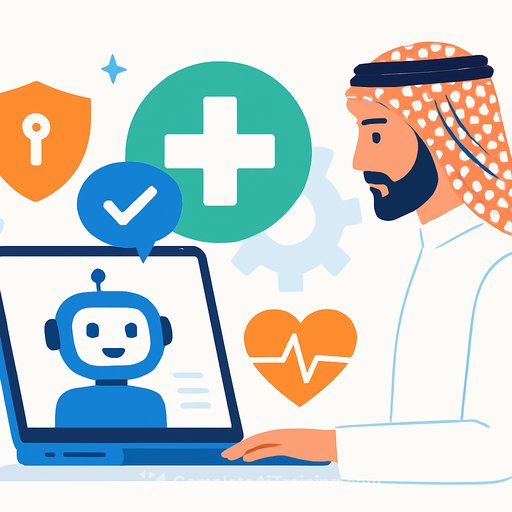Decoding trust in large language models for healthcare in Saudi Arabia
LLMs like ChatGPT are moving into patient education, symptom assessment, and decision support. In Saudi Arabia, trust is the gatekeeper. This article distills evidence from a survey of 303 adults and a PLS-SEM analysis to show what drives trust, satisfaction, and actual use in healthcare contexts.
The short answer: reliability, security, and transparency matter most. Trust converts AI outputs into decisions; satisfaction sustains use.
Why trust is the deciding factor
Healthcare tolerates little uncertainty. If an AI delivers inconsistent or opaque guidance, clinicians and patients pull back fast.
In this study, trust was influenced by competence, reliability, transparency, security, persuasiveness, and perceived trustworthiness. Ten of fifteen hypotheses held, underscoring that trust and satisfaction directly influence adoption in clinical and patient-facing workflows.
What the study tested
The model blended trusted frameworks: Technology Acceptance Model (TAM), Health Belief Model (HBM), trust-in-technology constructs, and usability factors. It assessed how competence, reliability, transparency, security, persuasiveness, and non-manipulative design feed into trustworthiness.
Trust then influenced two decision constructs: "Helps Make Decisions" and "Makes Decisions Based on ChatGPT," plus satisfaction and future use intention. The analysis used PLS-SEM on responses from 303 adults in Saudi Arabia (50.83% men, 49.17% women), with reliable scales (Cronbach's alpha ≥ 0.70).
Key findings you can use
- Reliability first: Consistent, accurate outputs were the strongest driver of trust and decision use.
- Security is non-negotiable: Confidence in data protection and privacy increased willingness to engage with AI in care pathways.
- Transparency enables action: Clear rationale, source visibility, and limits-of-knowledge notices boosted adherence to AI guidance.
- Persuasiveness cuts both ways: Helpful framing improves adherence, but must avoid undue influence; non-manipulative design supports ethical use.
- Satisfaction sustains adoption: When AI saves time, reduces friction, and improves access, users intend to keep using it.
- Human oversight remains essential: Trust increased reliance on AI for support, not replacement of clinicians.
Saudi context: what changes on the ground
Culture, language, and regulation influence acceptance. Arabic fluency, respect for local norms, and alignment with Saudi data laws are critical to trust.
Vision 2030 and digital health initiatives raise expectations for safe, explainable, and secure AI in care settings. Strong governance and clinician oversight are expected, not optional.
Practical implementation guide
- Make reliability measurable: Clinically validate AI outputs for target use cases; track accuracy, consistency, and escalation rates. Establish fallback to human review for uncertainty.
- Engineer transparency: Show sources, summarize reasoning, and label confidence. Display model limitations and when to defer to a clinician.
- Secure by default: Enforce least-privilege access, encryption in transit/at rest, audit logs, and data minimization. Align with local and international standards where applicable (e.g., HIPAA Privacy Rule and WHO guidance on AI in health ethics and governance).
- Guard against bias: Test performance across demographics; implement bias audits, re-training, and clinician review of edge cases.
- Design for non-manipulation: Avoid coercive wording. Provide options, alternatives, and clear consent prompts. Log when persuasive nudges are used.
- Fit clinical workflows: Integrate with EHR/telehealth tools; use structured outputs (problem, rationale, next steps, red flags); support Arabic and clinical terminology.
- Operationalize satisfaction: Measure user satisfaction and task success. Triage user feedback into model updates and UX fixes.
- Clarify roles and liability: Define what the AI may suggest vs. what must be clinician-confirmed. Provide visible disclaimers and escalation paths.
- Protect privacy in KSA: Comply with national data regulations and organizational policies for data residency, retention, and consent.
Clinical use cases that benefit
- Patient education: Clear, source-backed explanations with culturally appropriate phrasing and reading levels.
- Symptom triage: Structured risk flags and safety-net advice with immediate escalation for red flags.
- Clinical decision support: Evidence summaries, differential considerations, and guideline reminders, always reviewable by clinicians.
- Operational efficiency: Drafting discharge instructions, outreach messages, and follow-up checklists for clinician approval.
Measurement checklist
- Trust score (perceived reliability, security, transparency)
- Decision support use (frequency, adherence, escalation rate)
- Clinical accuracy (by use case), turnaround time, and rework rate
- Safety metrics (false negatives/positives in triage, adverse events, overrides)
- User satisfaction (patients and clinicians), future use intention
Method highlights (for data-driven teams)
Survey of 303 adults in Saudi Arabia, near-equal gender distribution, diverse education levels led by Bachelor's degrees. Five-point Likert scales assessed competence, reliability, transparency, security, persuasiveness, trustworthiness, satisfaction, and decision-making constructs.
Data were cleaned for completeness and consistency; internal reliability met accepted thresholds. PLS-SEM tested relationships across constructs; 10 of 15 hypotheses were supported, with reliability, security, and transparency standing out.
What this means for healthcare leaders
Do not deploy generic chatbots and hope for adoption. Build for measurable reliability, visible transparency, and clear security, then validate in real workflows.
Keep clinicians in the loop, document accountability, and communicate boundaries to patients. Trust grows when systems are safe, explainable, and genuinely useful.
Level up your team's AI capability
If your clinical or digital teams need practical training on ChatGPT and related tools, explore role-based options here: AI courses by job.
Bottom line
Trust is built on reliability, security, and transparency. Get those right, and AI becomes a credible assistant for patient education, triage, and clinician support-without replacing human judgment.
Design for safety, explainability, and cultural fit in Saudi healthcare. That's how AI earns its place in care.
Your membership also unlocks:






